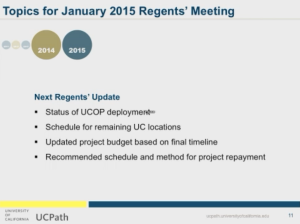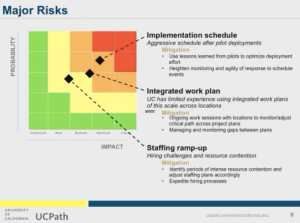Chris Newfield has an excellent post at Remaking the University about the University of California’s budget situation and how it relates to the recent Moody’s negative outlook on higher education finances. The whole article is worth reading, but one section jumped off the page for me [emphasis added].
The sadder example of ongoing debt is the request for “external financing for the UCPath project.” UC Path was UCOP’s flagship solution to UC inefficiencies that were allegedly wasting taxpayers’ money–in other words, new enterprise software for the systemwide consolidation of payroll and human resources functions. This is boring, important back office stuff, hardly good material for a political campaign to show the state “UC means business,” but that’s what it became. Rather than funding each campus’s decades-old effort to upgrade its systems on its own, UCOP sought centralization, which predictably introduced new levels of cost, complexity, and inefficiency, since centralization is often not actually efficient.
I had heard nothing good about UC Path from people trying to implement it on campuses, and have tried to ignore it, but this week it has resurfaced as a problem at the Regental level. The project timeline has grown from 48 to 72 months, and its costs are said to be $220 million (it had spent $131 million by May 2014) . Worse, the repayment schedule has mushroomed from seven to twenty years. Annual payments are to be something like $25 million. Campuses are to be taxed to pay for 2015-era systems until 2035, which is like taking out a twenty year mortgage to pay for your refrigerator, except that your fridge will be working better in 2035 than next year’s PeopleSoft product. Since the concurrent budget document notes efficiency savings of $30 million per year (top of page 4), UCOP may be spending $220 million to save a net $5 million per year over a couple of decades–and going into debt to do it. In the end, an efficiency measure has turned into a literal liability.
What the hell – a $220 million project to save money? How did this project get in this much trouble?
The UCPath project concept originated in 2009 with the project announcement coming in late 2011. The goal is to replace the Payroll Personnel System (PPS) that runs separately for each of the 11 UC locations with Oracle’s PeopleSoft payroll and HR systems. PPS is over 30 years old, and there are major risk issues with such an old system as well as a host of inefficient processes. The original project plans were based on a $170 million budget1 with the first wave of go-live for the Office of the President and 3 campuses scheduled for early 2013. All campuses would be live on the new system by late 2014.2
In a presentation to the Board of Regents in January 2012:
Over the same period, cost reductions are expected to be approximately $750 million from technology efficiency gains, process standardization and consolidation of transactional activities into a UC-wide shared services center. Overall, the project has a net present value of approximately $230 million (at a nine percent discount rate) with breakeven in year 5.
Subsequent promises were made in March of 2012:
We think this project is likely to pay for itself within five years, and UC could be accruing over $100 million in annual savings by the eighth year,” said Peter Taylor, UC’s chief financial officer. “We also expect to deliver HR and payroll services with increased efficiency, accuracy and quality.”
At the Board of Regents’ meeting last week, the project team gave the first update to the regents since January 2012 (itself a troubling sign). See this Sharestream video from 2:56:10 – 3:22:40.
By Fall 2013 the project was in trouble, and UC leadership brought in new leadership for the project: Mark Cianca as Deputy CIO and Sabu Varghese as Program Director. Their first act was to do a health check on the project, and the results were not pretty (as described in last week’s Board of Regents’ meeting).
- The project team and implementation partner (Oracle) had treated the project as a software replacement rather than a fundamental business transformation initiative.
- The individual campuses had not been consulted on changes in business processes, and in fact they had not even been asked to sign off on future state business processes that each campus would have to run to stay in operation.
- The new project team had to go through more than 100 future state processes with campuses and get agreement on how to proceed.
The result, as described by UC President Janet Napolitano at last week’s meeting, was the team having to “reboot the entire project”.
Based on the reboot, the current plan is $220 million with first wave complete by February 2016 and all campuses live by mid 2017. That’s $50 million over budget and 24 months over schedule.
But the planning is not complete. They are working up their “final” replan of budget and timeline, which they will present in January 2015.
How solid is the current estimate? The implementation schedule is listed as the highest risk, even with the delays.
The project financing has changed so much that UC is now facing the need to use external financing over a much longer term, as described in the material for last week’s board meeting.
Therefore, this item seeks approval to refinance the UCPath loan out of CapEquip and into external financing to achieve the financing customization required. As indicated above, the original repayment plan based on the $220.5 million budget was expected to have been repaid with annual debt service of $25 million. This would have resulted in a 12-year loan term once principal was to be repaid. In January 2015, UCPath project leadership plans to present a revised project timeline, a revised project budget and a revised estimated loan repayment schedule. Project leadership will work with the campus budget officers (and campus budget department staff) to develop: (1) an appropriate campus cost allocation strategy; (2) an estimated repayment schedule that will reflect commencement of principal repayments in conjunction with the final campus deployment (estimated to be early 2017); and (3) an estimated 15-20 year loan repayment period.
Notes
- The new project team seems quite credible, and for the most part they addressed the right points during the briefing. Kudos to UC for making this change in leadership.
- This is a major project turnaround (or reboot, in Napolitano’s words), but I’m not sure that UC had communicated the significance of the project changes to system campuses (and certainly not to the media).
- I would view the current plan of $220 million and Q1 2017 full deployment as best case situation – the team told the regents that they were going to update the plan, and ERP project almost never come in earlier than planned.
- The actual amount is much higher than $220 based on this footnote: “The $10 million in tenant improvements approved for the UCPath Center Riverside site as well as the $17.4 million purchase of the facility (UCPath is currently projected to use no more than 50 percent of the building) are not included in the figures above.”
- How do you go 2.5 years between updates from what is now a quarter billion dollar project?
- What about the current estimate of benefits – is it $30 million per year as Chris described or closer to $100 million per year? One big concern I have is that the information on project benefits was not updated, presented to the regents, or asked by the regents. While I question the $25 million financing and $30 million benefits numbers, I think Chris got it exactly right by noting how UC administration is failing to ask hard questions:
Moving forward, I’m afraid that officials are going to have to get much better at admitting mistakes like UCPath, and then actually undoing them. I couldn’t listen to the recording of the UCPath conversation, but Cloudminder made it sound like a lot of restrained finger-pointing with no solution in sight. Did anyone say, “well, this seemed like a good idea at the time, but it’s not. Let’s just cancel it, figure out where we went wrong, and come up with something better”?
It is possible that continuing with the rebooted project is the right answer, but UC is not even asking the question. Failing to ask whether 15-20 year financing of a new ERP makes sense seems like a major oversight. Won’t this lock UC into an Oracle system that is already antiquated for another two decades or more? It seems stunning to me that UC is planning to commit to $220 million of external financing without asking some basic questions.



[…] ← University of California’s $220 million payroll project reboot […]